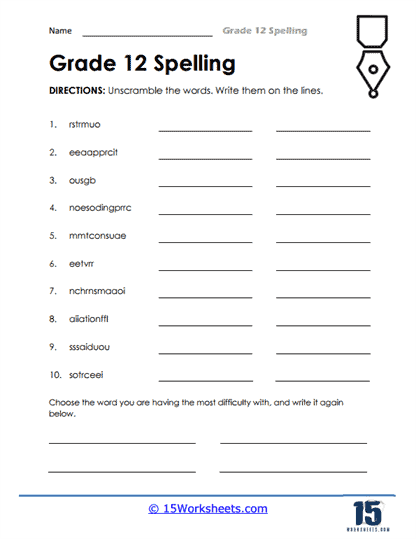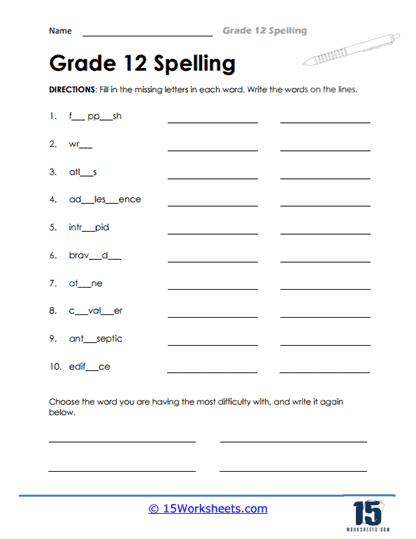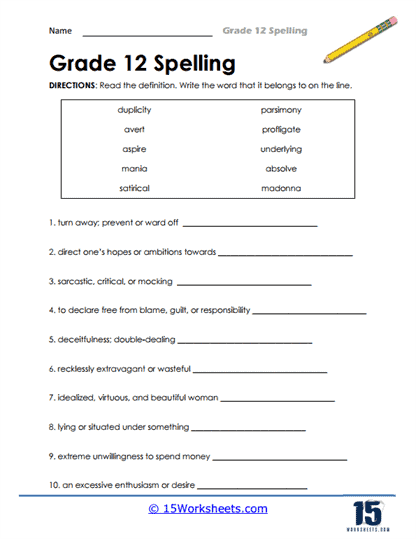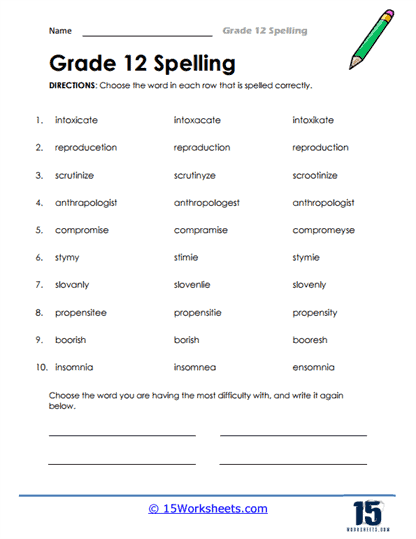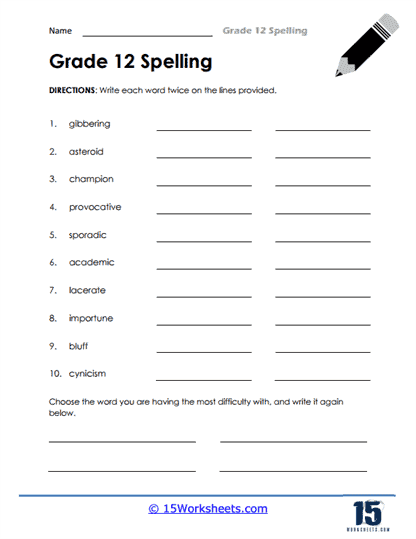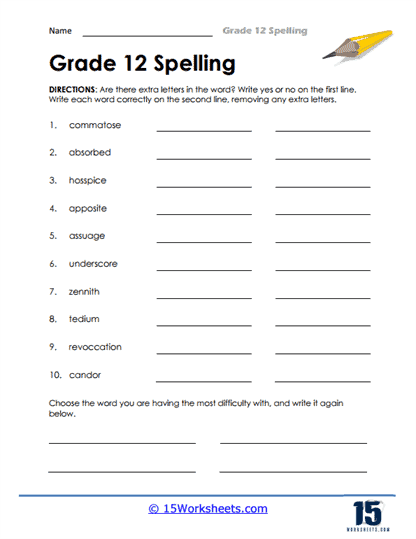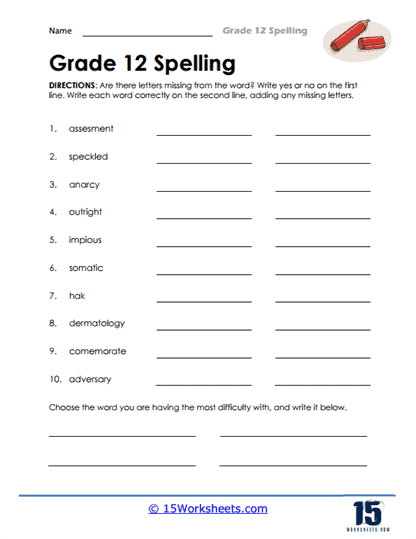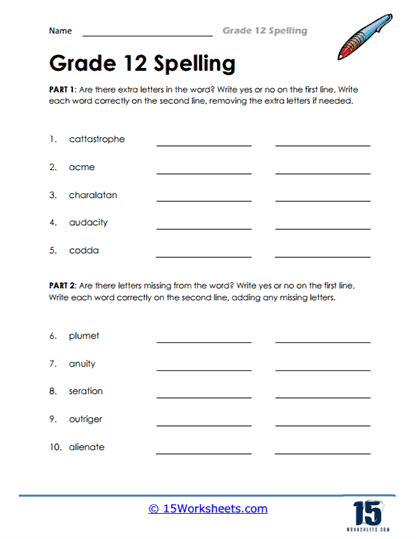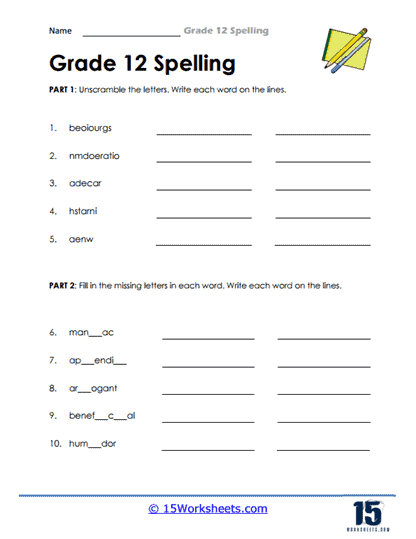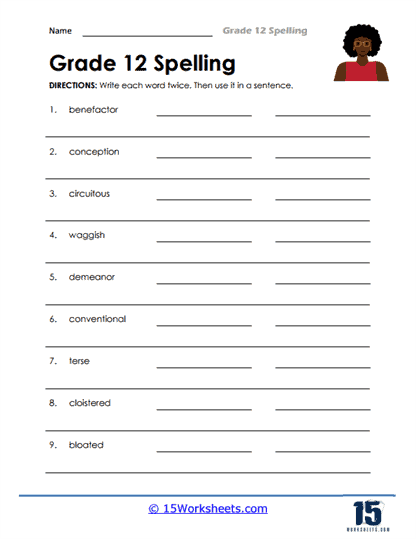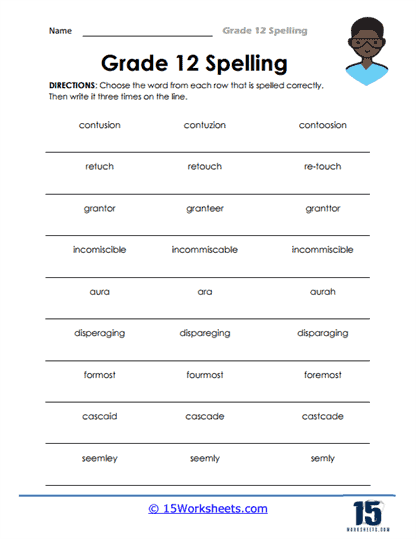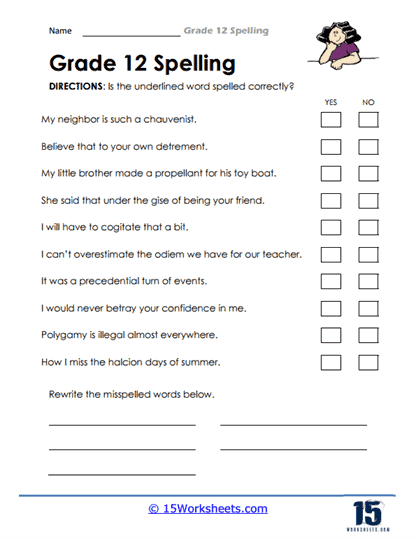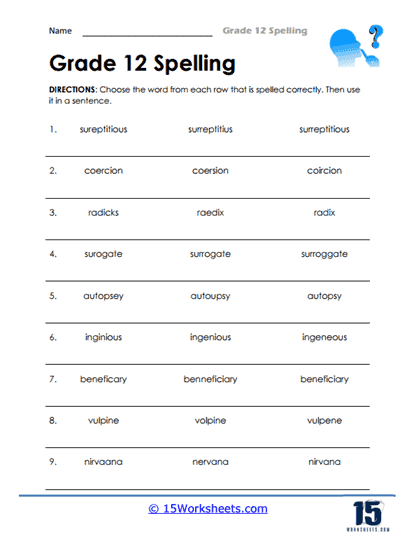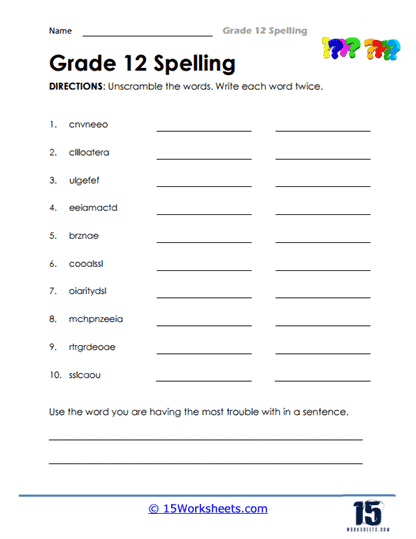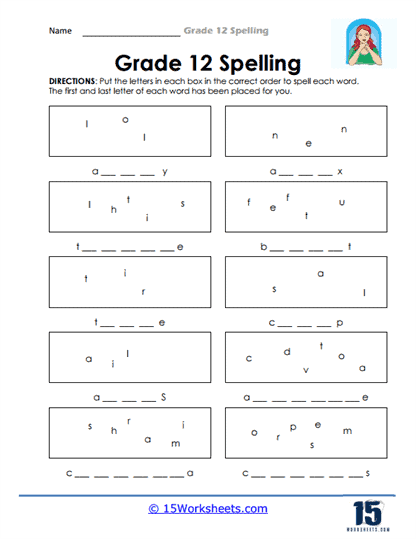Grade 12 Spelling Worksheets
All About These 15 Worksheets
These 12 grade spelling worksheets were designed for helping students refine and enhance their language skills in preparation for graduation and beyond. As students approach the end of their high school journey, the need to master complex vocabulary, spelling rules, and patterns becomes critical, particularly for those preparing for college or entering the workforce. These worksheets offer a structured, challenging way for students to work on their proficiency with advanced words, providing targeted practice to improve their spelling accuracy and deepen their understanding of language.
These worksheets are meticulously crafted to address the common challenges that students at this stage of learning encounter, such as unfamiliar vocabulary, difficult spelling patterns, and the nuances of word usage. They are designed not only to reinforce spelling rules but also to expand students’ vocabulary by introducing them to words they may not have encountered frequently. With an emphasis on practice and repetition, these materials give students multiple opportunities to correct their mistakes and learn from them, which is essential for long-term retention and language mastery.
This series of worksheets serve as an invaluable resource for students transitioning into more advanced forms of communication. By focusing on the practical application of words-whether through writing or recognizing words in context-these materials prepare students for the more rigorous demands of academic and professional writing. As students engage with these worksheets, they are better equipped to handle complex texts and write with greater precision, clarity, and confidence.
Types of Work Expected
These worksheets include a variety of exercises aimed at challenging students’ vocabulary knowledge and spelling abilities. One type of activity that students will encounter is the unscrambling of letters to form advanced vocabulary words. This type of task requires students to have a strong grasp of word structure and spelling conventions, as they must mentally arrange letters into meaningful words. This exercise is particularly useful for reinforcing familiarity with complex terms that students may encounter in both academic and professional settings.
Another type of activity focuses on determining the correct word based on given definitions. In this section, students are provided with definitions and must identify the corresponding term. This task not only reinforces spelling but also requires students to recall precise vocabulary and apply it in context. It’s an excellent exercise for building vocabulary, as students are exposed to new terms and are challenged to connect the definition to the correct word, which strengthens both their memory and their understanding of word meanings.
Error correction tasks also feature prominently in these worksheets. Students are asked to spot and correct misspelled words within a given list or passage. This activity sharpens their attention to detail and helps them internalize spelling rules by learning to identify and rectify common mistakes. This is a vital skill for proofreading and editing, which will be particularly important as they move into more demanding academic environments where polished writing is expected.
These worksheets offer opportunities for students to practice writing advanced words by using them in sentences. This exercise not only reinforces spelling but also requires students to understand how to use these words properly within a sentence structure. By placing new vocabulary in context, students develop a deeper comprehension of the words’ meanings and applications, which is critical for both written and spoken communication.
Students will be tasked with applying their knowledge of spelling and word meanings by using the words correctly in sentences or essays. This culminates the various skills learned throughout the worksheet series, allowing students to demonstrate their ability to spell, understand, and apply advanced vocabulary in writing. By combining all these aspects-unscrambling, defining, correcting, and writing-the Grade 12 spelling worksheets ensure that students are not only improving their spelling accuracy but also enhancing their overall language arts proficiency, preparing them for the next phase of their academic or professional careers.
What to Do When You Come Across Words You Can’t Spell
When you come across a word that you can’t spell, the first step is to break the word down into smaller, more manageable parts. Most words consist of prefixes, root words, and suffixes, and by identifying these components, you can often make an educated guess about the spelling. For example, if you recognize a common prefix like “un-” or a familiar suffix like “-tion,” you can build around those known elements. This strategy not only helps with spelling but also deepens your understanding of how words are constructed, making it easier to tackle similar words in the future.
Another helpful tactic is to sound the word out slowly. Even though English can be tricky with words that are not spelled phonetically, many words do follow sound-based patterns. By articulating each syllable clearly, you may be able to identify key letters or combinations that are essential to the correct spelling. However, it’s important to be mindful of silent letters and irregular spellings, so while sounding it out can guide you, it should be paired with other strategies for verification.
If you’re still unsure about how to spell the word, one of the most reliable tools is a dictionary or an online spell-checker. These resources allow you to search for words by entering the letters you know, and they will provide the correct spelling along with the definition. In today’s digital age, using online tools or apps can be a quick and effective solution, as many of these platforms offer suggestions and auto-corrections as you type. Even if you don’t know the full spelling, these tools can often predict the word based on partial input or context, which can save time and improve accuracy.
Another useful approach is to write the word down in different ways, especially if you have a rough idea of how it should look. By experimenting with various spellings, you can sometimes recognize which one looks most familiar or correct. This method taps into your visual memory of words you’ve read before, helping you narrow down the options. Additionally, if you’re writing digitally, your word processor may underline misspelled words, giving you a clue that the spelling is incorrect and prompting you to try again.
If you’re in a situation where you can’t immediately look up the correct spelling, consider using a synonym or rephrasing the sentence to avoid the tricky word altogether. While it’s important to learn the correct spelling eventually, sometimes the best short-term solution is to work around the problem, ensuring that your writing remains clear and professional without being hindered by an unfamiliar word. This approach can also encourage you to expand your vocabulary by exploring alternative ways to express your ideas.

